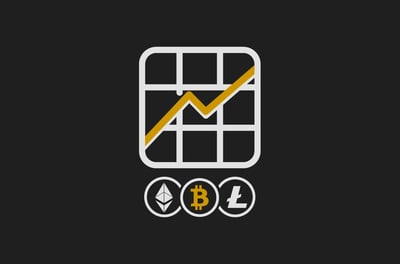Table Of Contents
- What is Scalping?
- How Do Scalpers Make Money?
- Crypto Scalping Risks
- Crypto Scalping Vs. FOREX Scalping
- Similarities between crypto and FOREX scalping
- Differences between crypto and FOREX scalping
- Advantages and Disadvantages of Crypto Scalping
- Advantages of scalping crypto
- Disadvantages of scalping crypto
- Cryptocurrency Scalping Strategies
- Bid-ask spread
- Trend trading strategies
- Countertrend trading
- Range strategies
- Statistical traders
- Scalping Tools
- Bots
- Signals
- Technical indicators
- Top 10 Crypto Scalping Trading Rules for Beginners
- 1. Choose a broker with strong technology
- 2. Reliable order execution
- 3. Research the broker’s fees
- 4. Implement stable strategies
- 5. Combine buying short with long
- 6. Master technical analysis
- 7. Volume
- 8. Discipline
- 9. Open a demo account
- 10. Educate yourself about scalping crypto
- The Bottom Line
A Beginner's Guide to Scalping Cryptocurrency
In my experience, scalping is an exciting trading style that involves traders attempting to make profits from small price movements. It is a thrilling and energetic pursuit that requires traders to actively monitor their positions as all trades must be opened and closed within the same day. By collecting small profits many times over, traders can generate substantial earnings.
Guided by indicators generated by powerful technology, scalpers are constantly on the hunt for the smallest chinks of daylight between bid-and-ask spreads with a view to buying low and selling at a higher level, even if the profit is marginal.
Scalping is a form of trading where traders open a position with the full intention of closing it for a profit during the same trading session. With some forms of day trading, investors can enter a limited number of positions, say, as few as five, and be satisfied with their work for the day. In this article, I will explain what scalping is so you can understand if this trading strategy is for you.
Scalping is a high-speed trading method that involves opening and closing many small trades within the same day to profit from tiny price movements.
Traders can choose between manual scalping, which requires intense market monitoring, and automated strategies that rely on pre-set algorithmic rules.
Crypto scalping relies heavily on real-time technical indicators like RSI, Bollinger Bands, and Fibonacci tools to detect short-term opportunities.
The main risks in scalping include slippage during volatile events, high trading fees, and overexposure from using leverage irresponsibly.
While crypto and FOREX scalping share similarities, crypto is more volatile, less liquid, less regulated, and operates 24/7.
Core strategies include trading on bid-ask spreads, riding trend momentum, exploiting countertrends, trading within price ranges, and using statistical anomalies.
Scalpers rely on powerful tools such as bots for execution, trading signals for timely alerts, and indicators to track price behavior.
Your success depends on factors like strong platform execution, fee awareness, disciplined strategies, technical analysis, and high trading volume.
What is Scalping?
I have learned that for a trade to qualify as scalping, traders must open and close their positions within the same day. Scalping can be used to trade in many different asset classes, be it FOREX, stocks, or crypto. In our analysis, we will concentrate on scalping as it relates to crypto. Scalping is an extreme brand of day trading that sometimes sees traders perform a high-wire act of opening hundreds of positions at the same time. It is an intense, concentrated form of trading that involves exploiting small bid-ask price gaps in assets.
Day traders deal in analysis charts that cover price trends ranging from five minutes to 30 minutes. However, some scalpers would find those intervals too long, as they often use 15-second or half-minute charts to make decisions. To succeed, scalpers must be attuned to the news. The crypto market is highly sensitive to economic releases and breaking market news, especially those directly involving crypto. If an influential figure has a negative opinion of crypto, even this can sway the price. It is during those minuscule price oscillations that scalpers pounce.
To maximize their earnings, crypto scalpers make the most of leverage. Even if they are not well capitalized, they can vastly increase their position sizes through leverage. While there is a risk of losing more money this way, the attraction has always been that you can trade outside of your capital bracket if you have access to generous leverage.
I have seen that scalpers employ a combination of manual and automatic strategies. For those traders who prefer the old school approach of watching the markets themselves, part of this manual approach sees them hovering over a computer screen for hours to spot the changes that they are looking to take advantage of. Automated strategies involving trading bots largely remove the need to hover over the markets so intensely, as traders can carefully insert parameters inside which their trades will operate, thus removing the need for constant management.
At times, the crypto market is gripped in a cycle of volatility. In early 2023, the price of Bitcoin nearly halved in value in the space of a month. The average scalper would have quickly spotted the early trends and would have drastically reduced their position sizes and their number of trades. By contrast, a swing trader, who often keeps positions open for weeks and months, would have waited out the volatility.
Scalpers are looking to buy crypto coins at low prices and sell them for a profit. They are content to take profits as small as a few basis points (one basis point is equal to 0.01%) because they deal in high volumes.
Recommended Brokers
How Do Scalpers Make Money?
Over the course of my trading career, I have seen that trading and investment strategies can differ markedly among traders. There are no strict rules for achieving profits while scalping. Before they start, every trader needs to formulate their own trading strategy. There are two main approaches to scalping – manual and automated.
Manual trading involves the trader closely monitoring the market to continuously track price movements. A few scalpers have gained so much experience that they can trade manually and work off informed guesses. In some instances, a scalper is so seasoned and experienced that they can make trading calls based on instinct and memory. This is known as intuitive scalping.
These traders are few, and their experience affords them the luxury of working with limited technical insights. You are not advised to start your scalping career this way, as it will likely not last very long. For most scalpers, having access to quality real-time technical analysis is crucial. Here, the trader monitors charts and indicators to stay aligned with market activity. Despite using technical analysis as a guide, many scalpers spend significant time at their computers. This way, they can remain in positions for as little as a few minutes at a time.
Automated trading uses scalpers guided by algorithms to support their chosen strategies. By using a program, traders can stay closely aligned with their chosen plans without worrying about missing a close or having to decide what to do when a position enters a certain range. Traders in this space can even step away from their desks for a time and let the algorithms do the work.
You might wonder what sort of technical analysis scalpers undertake. They are mainly concerned with information like moving averages, charts, candlesticks, trading volume, price action, and the oscillation between the low and high bands of an asset’s value, known as support and resistance levels.
In my view, the best brokers and crypto exchanges have developed advanced technology that can generate insightful graphical representations of how prices are trending over a specified time period. More advanced traders would be interested in technical indicators, such as the Relative Strength Index (RSI), Bollinger Bands, and the Fibonacci retracement tool.
As far as technical analysis goes, this is where brokers and crypto exchanges set themselves apart. Using these technical tools, traders can tailor their analysis to the data they consider most important for their strategies. These custom indicators require that a trader have a full range of tools from which to work. Many scalpers use a combination of tools, including real-time order book analysis, volume profile, open interest, and other advanced indicators.
A little-known fact about the scalping world is that successful traders can often be quite secretive. Even in the age of social copy trading, some successful traders would not trade their most important secrets for a commission based on who is copying their trades. First, scalping is too frenetic a trading style to easily deploy copy trading, and second, successful scalpers themselves believe that the more people know about a successful strategy, the smaller their chances of profiting.
I've seen firsthand that crypto scalping comes with risks. In a high-frequency intraday trading style, profits can accumulate quickly. Of course, the flip side is that losses can accumulate just as quickly. Successful crypto scalping, especially when based on technical analysis, depends largely on the quality of the indicators and the timeliness of the information on which a scalper bases their decisions.
Leverage, of course, is another big risk to traders. While it can boost a trader's profit potential, scaling up position sizes also carries risk.
Another risk is slippage. Even if you put in place stop-loss orders, if the market moves faster than your broker can execute a stop-loss, you can end up losing more than you thought. Around the time of important financial releases like earnings reports, slippage is common, and these scenarios can deplete an account quickly.
Another risk, albeit manageable, is fees. Traders should be aware that if they execute hundreds of trades per day, they can quickly incur significant fee obligations. Of course, this is part of the cost of doing business. Most of the time, responsible traders understand how to price fees into their strategies. The key is to understand what fees you are paying so you can factor them in. It is fair to say that those who don’t have a handle on fees can get a nasty surprise. That's why it's important to include this consideration in your trading plan.
Crypto Scalping Risks

Crypto Scalping Vs. FOREX Scalping
In my opinion, scalping in these two markets is similar in some respects but different in others. FOREX scalping predates crypto scalping by many decades, as the FOREX industry predates crypto. Here are some of the biggest similarities and differences:
Similarities between crypto and FOREX scalping
Scalping in crypto and FOREX is very similar. At a high level, both practices concern the trading of forms of currency. The idea is to buy at a certain level and sell at a higher level for a profit. These are the main similarities:
1. Market dynamics
The dynamics of the markets have many factors in common. They are both open markets that feature traders who buy and sell forms of currency on an open market according to their strategies. As the largest financial market in the world, FOREX is more stable in terms of liquidity. This means there is always someone somewhere willing to buy the currency you are selling. FOREX plays an important role in global trade and is more established. Crypto works in the same way, but is a much smaller market. It is prone to occasional lulls during which time traders may not want to trade, especially after market-shaping news has broken.
2. Technology platforms
Both instruments can be purchased on digitally enabled platforms, meaning that traders can take part in these markets from the comfort of their own homes. We are not far removed from a time when a great deal of currency trading took place in a central place, like a stock exchange or a commodity trading floor.
3. Indicators
Many of the fundamentals around indicators remain the same for both forms of trading. Remember, you are trying to achieve the same thing in both, so getting to know the behaviour of support and resistance levels in a graphical form, such as live charts, is equally useful in each case.
Differences between crypto and FOREX scalping
I have seen that since scalping is such an involved exercise, traders often settle on trading one asset class for any given period. This is where preferences form for certain traders, as it becomes clearer which instrument suits their strategy. Crypto scalping and FOREX scalping may share the similarities we have discussed, but they also have many important differences:
1. Volatility
The crypto market is much more volatile than the FOREX market, which is based on stable fiat currencies and major currency pairs that are an indispensable part of the global financial landscape. Yes, minor and exotic fiat currency pairs may be volatile, but nothing compared to the swings evident in the crypto world.
2. Stakeholders
One of the defining features of the FOREX world is that it has developed an extensive ecosystem of players drawn from liquidity providers to clearing houses and brokers. Each of these parties has a stake in the overall market that they actively protect. Crypto’s defining feature is that it presents a different take from what is to be found in the traditional space, meaning it has far fewer intermediaries beyond a broker and a crypto exchange.
3. Trading windows
The cryptocurrency market is perpetually available, whereas FOREX operates on more traditional lines with conventional business hours. Crypto scalpers can trade throughout the day and night if they have the inclination, but FOREX traders must follow market trading windows.
4. Regulation
This is perhaps one of the starkest differences when scalping crypto versus scalping FOREX. The FOREX world is heavily regulated, as it has developed in lock step with the rest of the financial world. Crypto, on the other hand, is in its infancy as a financial instrument and regulators around the world remain unsure how to manage and regulate it, resulting in crypto being sparsely regulated, if at all. Even central banks must decide how to treat digital currencies.
5. Market size
FOREX is the largest financial market in the world, larger even than the stock market. With a daily volume of $7 trillion by latest authoritative estimates, the annual size of the FOREX market reaches into quadrillions while the crypto market is measured in mere billions. For context, there are 1,000,000 billion in one quadrillion. That is the scale of the difference in market size between FOREX and crypto.
6. Volatility and liquidity
As crypto is a substantially smaller market, it has access to much less liquidity and is more subject to volatility. So, why do people invest in crypto? Many traders are attracted to the novelty of crypto. They figure that the area is underexplored and, like prospectors looking for gold, the earliest movers will make the most money.
It should be noted that volatility is not a small challenge. It can leave traders on edge, and it makes for a much more nail-biting trading experience, especially on bigger positions. FOREX is by far the more settled marketplace with limited volatility and the kind of liquidity that means traders can get out of it when the need arises.
7. Anonymity
Once again, crypto’s design intent has been to offer something different from fiat currencies. Crypto enjoys greater anonymity than traditional fiat-based trading. That said, crypto scalpers are never truly anonymous if they buy the underlying instrument and don’t trade it as a contract for difference (CFD). This is because every piece of the blockchain has information about the owners of cryptocurrencies whenever it changes hands. FOREX trading, by contrast, is highly traceable since all financial parties in the FOREX chain must abide by strict Know Your Customer (KYC) standards.
Advantages and Disadvantages of Crypto Scalping
This form of trading comes with its pros and cons, as does any form of trading. You are always advised to know what's good and what's not so good about any market you participate in.
Advantages of scalping crypto
1. Easily automated
Scalping crypto strategies can run on autopilot. It may take some effort up front, but once you have decided on your strategy and you know which indicators you want to follow, automating your exit from positions is simple.
2. Manageable risk
Truthfully, all trading risk is manageable. However, it is more manageable when the trader uses well-formulated strategies and manages their impulses to stray from the plan. Scalping is risky when traders use leverage to extend themselves. If they reign themselves in and build a strategy that only allows small losses, then the risk is reduced.
3. Profits to be made
Yes, scalping can be highly profitable if you have a great strategy and you are well-capitalized. Beyond the challenge of competing against professional traders and scalping bots, crypto is a space that still offers traders the opportunity to make money if they plan well.
Disadvantages of scalping crypto
1. Competition with bots
The crypto space is becoming increasingly manned by scalping bots that have the benefit of boundless computing power. That said, bots have not run human traders out of town. There is still space for dedicated scalpers to make money if they run well-crafted strategies and execute them consistently.
2. Requires fast action
Scalping strategies require rapid and decisive action. If your trading style requires that you be more patient and balanced, then perhaps you would do better in the slow-paced swing trading world.
3. Leverage
Leverage is often a blessing and a curse. When used well, it can allow you to make lots of money quickly. However, if it goes wrong, then leverage can make you lose money just as quickly.
4. Fees
Fees are an inescapable part of the trading world. However, the fact that crypto scalping fees are applicable to every single transaction, and scalpers enter hundreds of these every day, means fees can accumulate quickly. It is always best to make sure to understand your broker or crypto exchange’s rate card and that you are getting a deal you can afford.
Cryptocurrency Scalping Strategies
Bid-ask spread
When scalpers trade, they want to profit off the changes in the bid-ask spread of an asset. It is a fundamental practice to seek an advantageous difference between the price a broker or crypto exchange will buy a security from a scalper (the bid price) and the price the broker will sell it (the ask price). In simple terms, you want to buy low and sell high, in the context of scalping of course.
Trend trading strategies
When I trade in this way, I am normally looking to take advantage of trendlines. When a price starts to trend in a certain direction, I will look to buy the asset and sell it for a profit before the trend changes direction. This is called “catching the wave.” If the trend is going up, you want to buy on the upswing and offload before the trend starts to come back down.
Countertrend trading
This type of trading involves trying to anticipate what is known as a “pullback.” Price cycles bounce back and forth between the lower support and the and higher resistance levels of an asset’s value, and countertrend trading is when investors try to take up a position in the opposite direction of a trend. In practical terms, they try to anticipate a price coming down or going up so they can adopt a position that takes advantage of the change in direction.
Range strategies
When I'm range trading, I want to carefully identify the support and resistance levels of an asset. These are the lower and upper bands where the price has been trending, and my strategy is to buy at the lower end and sell at the upper end. This type of trading relies heavily on technical analysis, pinpointing the exact pricing levels so traders can stay within the anticipated range.
Statistical traders
These traders are looking for the slightest market inefficiencies or quirks. For example, they could do most of their trading on Tuesday mornings, when volumes are traditionally higher, rather than on Friday. They are looking for anomalies that only highly sensitive and detailed statistical charts can uncover. It could be based on the time, price, or day of the week.
Scalping Tools
I've done of the research on your behalf, and I can say that there are some tools that are very helpful to scalpers:
Bots
In truth, the cut and thrust of scalping is not for everyone. This is where bots enter. With powerful technology, traders can use dedicated scalping bots on platforms that require no coding.
Signals
Signals are a trading recommendation that is a trigger for action for a trader to act at a certain time on a specified financial asset. Signals are detailed enough to provide the suggested price execution level and the best time to do it. These highly useful market prompts are based on powerful, proprietary analysis undertaken by the best brokers and trading websites, like Arincen, which has its own powerful signals platform.
Technical indicators
Indicators give traders useful clues that inform their strategies. An indicator could capture an aspect of an asset over a period, such as the moving average of its price over a day. Indicators are not as powerful as signals, as they do not provide a call to action, but merely capture a statistical movement over a specified time.
Top 10 Crypto Scalping Trading Rules for Beginners
1. Choose a broker with strong technology
I know firsthand that scalping has a high emphasis on capable technology. You cannot afford to be let down by your tools. Some of the key requirements for a trading platform include a stable web interface and reliable stop-loss execution. If your stop-loss fails you, you can find yourself losing money.
2. Reliable order execution
This is an important part of scalping. You could have the best strategy and nominally be making a profit, but if you do not execute orders accurately and on time, any delay could wipe out your profits because the time windows are so small.
3. Research the broker’s fees
Fee research should be one of the first things you do before taking on a broker. The average scalper can enter hundreds of trades in a day. The commissions can rack up, meaning that traders need to carefully watch the fees they pay.
4. Implement stable strategies
Scalping is not a trading strategy to take on without thorough research. Learning to implement strategies such as range and countertrend trading requires practice and finesse.
5. Combine buying short with long
Beginners are usually more comfortable with buying long trades before they get enough experience. Buying long means they own the asset and expect it to appreciate. It is the fundamental act of buying at a certain price and selling it later at a higher price. However, there is also the short side, which is when scalpers buy an asset at a future price that is expected to fall. Shorting takes confidence and experience, and scalpers must be able to balance both styles.
6. Master technical analysis
In my experience, technical analysis teaches beginners not only about the market but also how to get ahead. There is fierce competition in the world of high-frequency trading. Trends rise and fall quickly, and you must always be switched on.
Technical analysis sets you apart, be it trading channels, moving average, ribbon entry strategy, or relative strength/weakness exit strategy. Understanding these concepts gives you the information you need to make the best decision.
7. Volume
There is no point in being a scalper and entering a small number of trades. The premise of the trading form is that you need to trade in high volumes and with high frequency. Liquidity is important, as are good platforms and tools with informative technical indicators.
8. Discipline
This is a requirement of all traders, but for scalpers especially. You do not have time to overthink decisions, and so you make your strategic decisions early and work from there.
9. Open a demo account
This is always good advice and cannot be overstated. Working with a demo account allows you to practice in a simulated environment. This is where you can brush up on your skills and gain crucial experience without the risk of losing money. It allows you to embed your strategies and test them as close to real market conditions as possible.
10. Educate yourself about scalping crypto
Again, as a trader, you should always go into the trading world with as much information as you can, even something as seemingly trivial as what time of the day is best to trade. Scalping is a rewarding but complex area that demands thorough research and practical experience
The Bottom Line
If there's anything I know as a trader, it is that scalping is fast-paced. The crypto market is highly volatile, characterized by rapid, constant change. It is also a high-intensity activity that requires full investment. If you do not have the temperament or the right trading psychology to take part in such a fast-moving market, or you are given to excesses of emotion, you are advised to stay out of it.
Your broker or crypto exchange will play a significant role in your success. They need to offer you the best tools and access to markets with good liquidity. Their order execution tools need to be robust and dependable, so you don’t miss out on opportunities.
Recommended Brokers
FAQ
Scalping is the act of entering many positions in a day with a view to making minute profits off those transactions. Scalpers try to buy low and sell high. They are supported by detailed technical indicators and rely on strong platforms that can execute their trades on demand.
Generally, you are looking for a coin that is part of a sizable market, where liquidity is not an issue. You can scalp any crypto coin that is available on a good crypto exchange, but if the coin is not well-known, you may run into difficulties getting access to liquidity, which is what greases the wheels of any market.
Yes, crypto scalping is legal. That said, you must first establish if crypto trading in general is legal in your jurisdiction. If crypto trading is legal in your country, then scalping crypto is legal.
Each broker or crypto exchange will ask for its own minimum deposit. Pay attention to the levels of leverage they offer so you can see how much margin you can access.
First, your need to research your broker for how well regulated, capitalized, and managed they are. Pay attention to the broker’s platform strength and the robustness and sophistication of their technology. Then, you are looking for a broker that provides excellent technical indicators. Signals are even better, even though not many brokers offer this.






